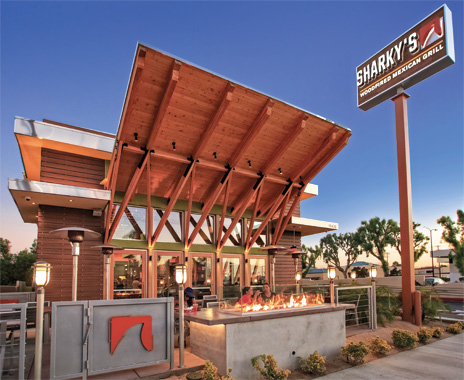In recent years, many limited-service brands have re-evaluated their ideas regarding new restaurant locations. Dropping cookie-cutter, one-size-fits-all buildings into any available space is no longer a sustainable expansion strategy in today’s economy.
Arby’s is one brand that has reconsidered its growth opportunities after the recession. The company recently announced its “Menu of Venues” approach to restaurant development, with various design plans for potential spaces. Through this program, Arby’s hopes to open 60 new restaurants in a variety of formats (with the new “Inspire” design prototype) this year, and remodel up to 160 more locations, writes Dave Gleason, director of franchising for Arby’s Restaurant Group Inc., in an email.
Specifically, the brand has designed models for building (and remodeling) three kinds of stores: standalone, end-cap (at the corner of a shopping center or other business), and urban in-line, which are placed within an existing shopping corridor. So far this year, Arby’s has completed more than 50 standalone stores, one urban in-line, and three end-cap stores with drive thrus.
“We’d like to be able to open an Arby’s restaurant in virtually any size space and in a variety of venues that may have [previously] created unaccustomed challenges,” Gleason says. “It also allows more flexibility for franchisees to open new restaurants and for Arby’s Restaurant Group Inc. as we’re evaluating new company-owned locations.”
In the past, considering a possible quick-serve site through spatial analytics was 80 percent art and 20 percent data, says Hal Hopson, managing director of applied analytics practice for Pitney Bowes, a data analysis consultancy.
However, with the availability of sophisticated data and modern training for analytics, those numbers have swapped, allowing analysts and restaurant owners to delve not only into the specific positives and negatives of any potential site, but also into the heads of potential customers through demographic and psychographic research.
“One of the things we do with our clients very early on is to understand where their customers are coming from,” Hopson says. “If we can understand where these customers live … that enables us to analyze which types of customers … find that [site design] most attractive.”
Spatial analytics, customer demographics, and psychographic data are key factors that the heads of Southern California–based Sharky’s Woodfired Mexican Grill have recognized when considering sites for new restaurants. COO David Goldstein says that while Sharky’s units are traditionally housed in end-cap sites in shopping centers anchored by day-use tenants, the brand recently completed build-out of a freestanding restaurant.
Goldstein and CEO Steve Paperno say freestanding stores are the most attractive option for the brand as it expands outside California because it offers the most possibilities for visibility for new customers who may not have tried the food. “It’s really important to understand your target market,” Paperno says. He adds that given the importance of customer traffic, “the biggest mistake in this business is choosing the wrong location.”
Following a strategic rebranding of Sbarro earlier this year, the company has also built its first-ever off-mall standalone store from the ground up—traditionally, Sbarro’s restaurants have been located in malls, casinos, and airports—with another feature completely new to the brand: delivery service.
It’s a big step for the company, and it’s intricately tied with site selection, says Anne Pritz, chief marketing officer of Sbarro. Whereas Sbarro’s pizza is traditionally sold by the slice, the company is now offering 12- and 17-inch pizzas for delivery at its standalone store near Columbus, Ohio. Another advantage of the standalone store is the accompanying parking lot, which allows customers to park and pick up their ready-made pizza.
Pritz says that while Sbarro will continue to put new restaurants in malls, casinos, and airports, she expects Sbarro to have built three additional standalone restaurants by the end of the year.
It’s important to maintain physical store features that customers recognize as brand-centric, regardless of the location, operators say. However, Sharky’s Goldstein says it’s also important to match a store’s format to fit the unique physical environment of the area, as well as the population’s tastes.
Sharky’s will soon renovate a historic 1950s-era diner in Los Angeles. The location will pay homage to the building’s past by keeping certain elements, but will still emphasize the Sharky’s brand through the menu and other interior details. The new store will also be the first Sharky’s location to offer breakfast, including huevos rancheros–style tortilla pizza.
In addition to matching the menu to the venue, a flexible design strategy allows brands to expand more nimbly. Gleason says that while Arby’s new push in design has focused largely on standalone restaurants, the brand is also looking into nontraditional formats for flexibility. End-cap and in-line stores typically take less upfront capital to build than standalone stores, he adds. However, Sbarro’s real estate director Scott Wallace says rent in malls is typically very expensive.
While location and demographic data are very important in the site selection process, Pitney Bowes’ Hopson says that the art aspect of site analysis is still an important factor. It is key to connect customers with menus and restaurant design.
“Understanding geographic relationships … is not always available from a spreadsheet,” Hopson says.







